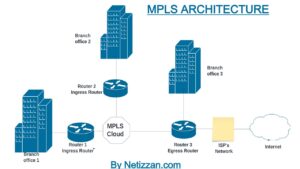In today’s modern world, seamless internet access plays an important role in facilitating efficient communication within organizations and ensuring reliable internet connectivity.
Two network transport technologies that often cause confusion people are Metro Ethernet and MPLS. While both technologies serve the purpose of moving traffic from one point to another, they still exhibit significant differences.
In this article, we will delve deep into Metro Ethernet vs. MPLS. We will begin by explaining each of those technologies and then conclude by showing you how they compare with each other.
TL;DR:
In case you are in rush, here is a summary of how MPLS compare with Metro ethernet;
| Factor | Metro Ethernet | MPLS |
|---|---|---|
| Network Layer | Data Link Layer (Layer 2) | Network Layer (Layer 3) |
| Function of Tech | Transport Network | Switching Network |
| Standard | IEEE 802.1Q (Ethernet) | IETF Standard |
| Application | Local Area Networks (LANs) and MANs | Wide Area Networks (WANs) and backbone networks |
| Service Types | Usually point-to-point or point-to-multipoint | Supports any-to-any connectivity |
| Traffic Engineering | Limited traffic engineering capabilities | Advanced traffic engineering features |
| Bandwidth | Typically higher bandwidth options | Bandwidth options may be limited |
| Scalability | Scalability limited by Ethernet's nature | Highly scalable for large networks |
| Scope of Operation | Typically within a metropolitan area | Suitable for regional and global networks |
| QoS | Generally lower QoS capabilities | Offers robust QoS with Traffic Engineering |
Let’s now go deeper;
What is Metro Ethernet?
Metro Ethernet is an Ethernet-based transport technology designed for interconnecting Local Area Networks (LANs) within a metropolitan area. It can also be used to connect an organization to their ISP.
Metro Ethernet is typically used to connect multiple LANs within a metropolitan area, creating a WAN-like network. It extends the Ethernet technology’s reach beyond the boundaries of a single LAN, allowing for seamless communication and data transfer between different locations in the metropolitan area. We will not go deep into metro ethernet as we already have a post that explains metro Ethernet in details.
What is MPLS?
Multi-Protocol Label Switching (MPLS) is a networking protocol that takes data packet routing to a whole new level. It operates at layer 2.5 of the OSI model, using labels to enhance the efficient routing of traffic.

Read about this MPLS Network Architecture
Here’s how MPLS works:
When a data packet enters the MPLS network, it gets a special label that contains the destination host’s identification (IP address). This label makes MPLS stand out from traditional routing protocols, which usually operate at layer 3 of the OSI model.
So, what’s the deal with these labels? Well, they are like magic tickets that allow the packet to hop from one router to another within the network without knowing the Layer 3 information. Each router knows where to send the packet next based on the label’s information. This process continues until the packet reaches its final destination.
Now, once the packet arrives at the last router before reaching the destination host, the label is taken off (or decapsulated). The IP address of the destination host is revealed, and the packet is then forwarded using Layer 3 protocols.
Because of this cool two-step process—encapsulating traffic at layer 2 and forwarding it with labels, and later decapsulating it at the final router for layer 3 forwarding—MPLS is often referred to as a layer 2.5 networking protocol. To learn more about MPLS, you can read our post that covers MPLS in details.
Metro Ethernet Vs. MPLS: What is the Exact Difference?
The main difference between them is that Metro Ethernet is an Ethernet-based technology used for interconnecting LANs within a metropolitan area, while MPLS (Multi-Protocol Label Switching) is a networking protocol that enhances data packet routing by using labels. They both do not contradict each other in a network; MPLS can be implemented in a Metro Ethernet-based network.
Metro Ethernet Vs. MPLS: Key Differences
1. Network Layer
One of the fundamental differences between Metro Ethernet and MPLS lies in their architectural levels. Metro Ethernet operates at Layer 2, making it well-suited for LAN extension and interconnecting local sites.
MPLS, on the other hand, operates at Layer 2.5, combining the best of both Layer 2 and Layer 3 technologies to provide efficient packet forwarding and routing capabilities.
Metro Ethernet uses switching techniques to handle packets within the network. It leverages MAC (Media Access Control) addresses to identify and deliver data packets to their intended destinations.
MPLS, on the other hand, employs label-based routing, where each packet is assigned a label at the entrance point and subsequently forwarded based on this label. This label swapping mechanism allows MPLS to optimize packet flow and achieve faster routing decisions.
2. Quality of Service
When it comes to handling Quality of Service (QoS), both Metro Ethernet and MPLS offer robust capabilities.
QoS refers to the ability to prioritize different types of network traffic based on their importance.
Metro Ethernet utilizes various QoS mechanisms, such as Differentiated Services Code Point (DSCP) markings, to prioritize traffic and ensure optimal performance for critical applications.
MPLS, too, excels in providing QoS features. Through the use of labels, MPLS enables the creation of Traffic Engineering (TE) tunnels, allowing network administrators to allocate bandwidth and prioritize traffic flows effectively. MPLS can prioritize real-time applications, such as voice and video, to ensure minimal latency and jitter, resulting in a seamless user experience.
When comparing the impact on performance and reliability, both Metro Ethernet and MPLS have proven track records. However, MPLS, with its label-based routing, offers greater flexibility in managing network traffic and adapting to changing demands.
3. Standard
In the case of Metro Ethernet, the Metro Ethernet Forum (MEF) has taken the lead in defining and promoting industry standards. The MEF has developed a comprehensive set of specifications known as Carrier Ethernet, which provides guidelines for implementing Metro Ethernet networks and services.
| Name | Speed | Distance |
|---|---|---|
| 100Base-LX10 | 10 Km | 100 Mbps |
| 1000Base-LX | 5 Km | 1 Gbps |
| 1000Base-LX10 | 10 Km | 1 Gbps |
| 1000Base-ZX | 100 Km | 1 Gbps |
| 10Gbase-LR | 10 Km | 10 Gbps |
| 10Gbase-ER | 40 Km | 10 Gbps |
| 40Gbase-LR4 | 10 Km | 40 Gbps |
| 100Gbase-ER4 | 40 Km | 100 Gbps |
MPLS, too, has it own standard. The Internet Engineering Task Force (IETF) instrumented the MPLS standards , this standard ensures that MPLS implementations from various vendors can seamlessly work together.
The MPLS standards cover a wide range of aspects, including label distribution, routing protocols, and Traffic Engineering.
4. Bandwidth
Bandwidth capabilities are crucial factors to consider when evaluating network technologies. Both Metro Ethernet and MPLS offer advantages and limitations in terms of bandwidth allocation and scalability.
Metro Ethernet excels at providing high-bandwidth connectivity, making it well-suited for bandwidth-intensive applications.
With its Ethernet technology foundation, Metro Ethernet can easily scale to accommodate growing bandwidth requirements. It allows organizations to allocate dedicated bandwidth to different locations, ensuring optimal performance for data-intensive tasks.
MPLS, although not originally designed as a high-bandwidth technology, has evolved to support higher speeds over time. It offers Traffic Engineering capabilities, which enable efficient utilization of available bandwidth and reduce congestion.
5. Cost
The cost factors associated with Metro Ethernet and MPLS implementations can vary based on several factors, including initial setup costs, recurring expenses, and potential cost savings.
Metro Ethernet, being a Layer 2 technology, often requires less complex equipment and configuration, resulting in relatively lower setup costs. Ethernet-based hardware is widely available, making it cost-effective for organizations seeking LAN extension or interconnection within a metropolitan area.
MPLS implementations typically involve more advanced hardware and configuration requirements, which can incur higher initial setup costs. However, MPLS offers potential cost savings in the long run by optimizing network traffic and allowing efficient utilization of available bandwidth. Organizations with geographically dispersed locations finds MPLS cost-effective due to its ability to consolidate network infrastructure and reduce recurring expenses.
6. Access Technology
Border Gateway Protocol (BGP) and Interior Gateway Protocol (IGP) are two access technology used by MPLs and Metro Ethernet.
In Metro Ethernet networks, BGP is typically used as the external routing protocol; it enables communication between different autonomous systems. BGP allows organizations to connect their Metro Ethernet networks to external networks, such as the internet or other service provider networks. Within the Metro Ethernet network itself, Interior Gateway Protocols (IGPs) like OSPF (Open Shortest Path First) or IS-IS (Intermediate System to Intermediate System) are commonly used for internal routing and achieving optimal packet forwarding.
In MPLS networks, BGP is often used as the underlying routing protocol to exchange routing information between different MPLS domains or autonomous systems. BGP helps establish MPLS label-switched paths (LSPs) and allows for interconnection between different MPLS networks. Within the MPLS network, IGPs like OSPF or IS-IS are used to populate the routing tables of MPLS-enabled routers, which ensure efficient label distribution and packet forwarding.
The choice of routing protocols in Metro Ethernet and MPLS networks can have implications for network management, configuration complexity, and the ability to interconnect with external networks.
7. Network Management
One of the notable aspects of Metro Ethernet is the level of control and configuration options available to customers. With Metro Ethernet, customers can actively manage and configure Layer 3 devices, such as routers, within their network infrastructure.
This level of control empowers organizations to customize their network settings, implement specific routing protocols, and optimize network performance based on their unique requirements.
Customer-managed Layer 3 devices in Metro Ethernet networks provide flexibility and granular control, which enables organizations to tailor their network to suit their business needs.
However, customer-managed Metro Ethernet networks also introduce additional responsibilities and challenges. Organizations must possess the necessary expertise and resources to handle network management tasks, including device configuration, routing protocol selection, and ongoing maintenance.
MPLS as the Core Technology with VPLS
MPLS serves as a powerful core technology that can be complemented by Virtual Private LAN Services (VPLS) to provide Metro Ethernet connectivity on the access side. VPLS extends Ethernet connectivity across MPLS networks, which allows organizations to establish virtual LANs that span geographically dispersed locations.
By leveraging MPLS as the core infrastructure and VPLS for access connectivity, organizations can achieve the benefits of both technologies. MPLS provides the efficiency and scalability of label-based routing, while VPLS offers the familiar Ethernet interface and seamless LAN extension capabilities.
VPLS is particularly useful in scenarios where organizations need to connect multiple sites and maintain a unified LAN environment, such as branch offices or campus networks. It simplifies network design and management, reduces complexity, and enhances network performance.
FAQ on Metro Ethernet Vs. MPLS
Here are some frequently asked question on how metro ethernet and MPLS compare;
Does Metro Ethernet use MPLS?
Metro Ethernet and MPLS are distinct technologies. Metro Ethernet does not inherently use MPLS, but MPLS can be implemented within a Metro Ethernet-based network for enhanced data routing.
Is MPLS the same as Ethernet?
No, MPLS is not the same as Ethernet. While both involve data packet transmission, MPLS is a specific networking protocol that operates at layer 2.5 of the OSI model, whereas Ethernet refers to a family of wired networking technologies operating at layer 2.
Conclusion
Both Metro Ethernet and MPLS are powerful networking technologies that serve distinct purposes and offer unique advantages. Metro Ethernet excels at providing high-speed LAN extension capabilities within a metropolitan area and offers scalability and cost-effectiveness.
On the other hand, MPLS combines Layer 2.5 technology with label-based routing to forward traffic within the network.

I am a passionate Networking Associate specializing in Telecommunications.
With a degree in Electronic engineering, I possess a strong understanding of electronic systems and the intricacies of telecommunications networks. I gained practical experience and valuable insights working for a prominent telecommunications company.
Additionally, I hold certifications in networking, which have solidified my expertise in network architecture, protocols, and optimization.
Through my writing skills, I aim to provide accurate and valuable knowledge in the networking field.
Connect with me on social media using the links below for more insights.
You can contact me using [email protected] or connect with me using any of the social media account linked below



